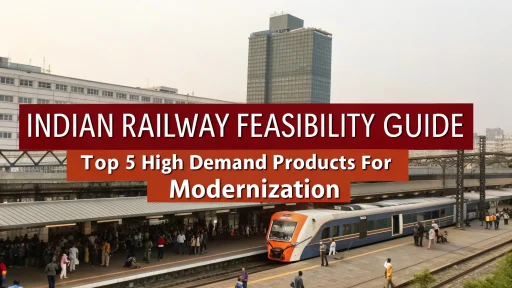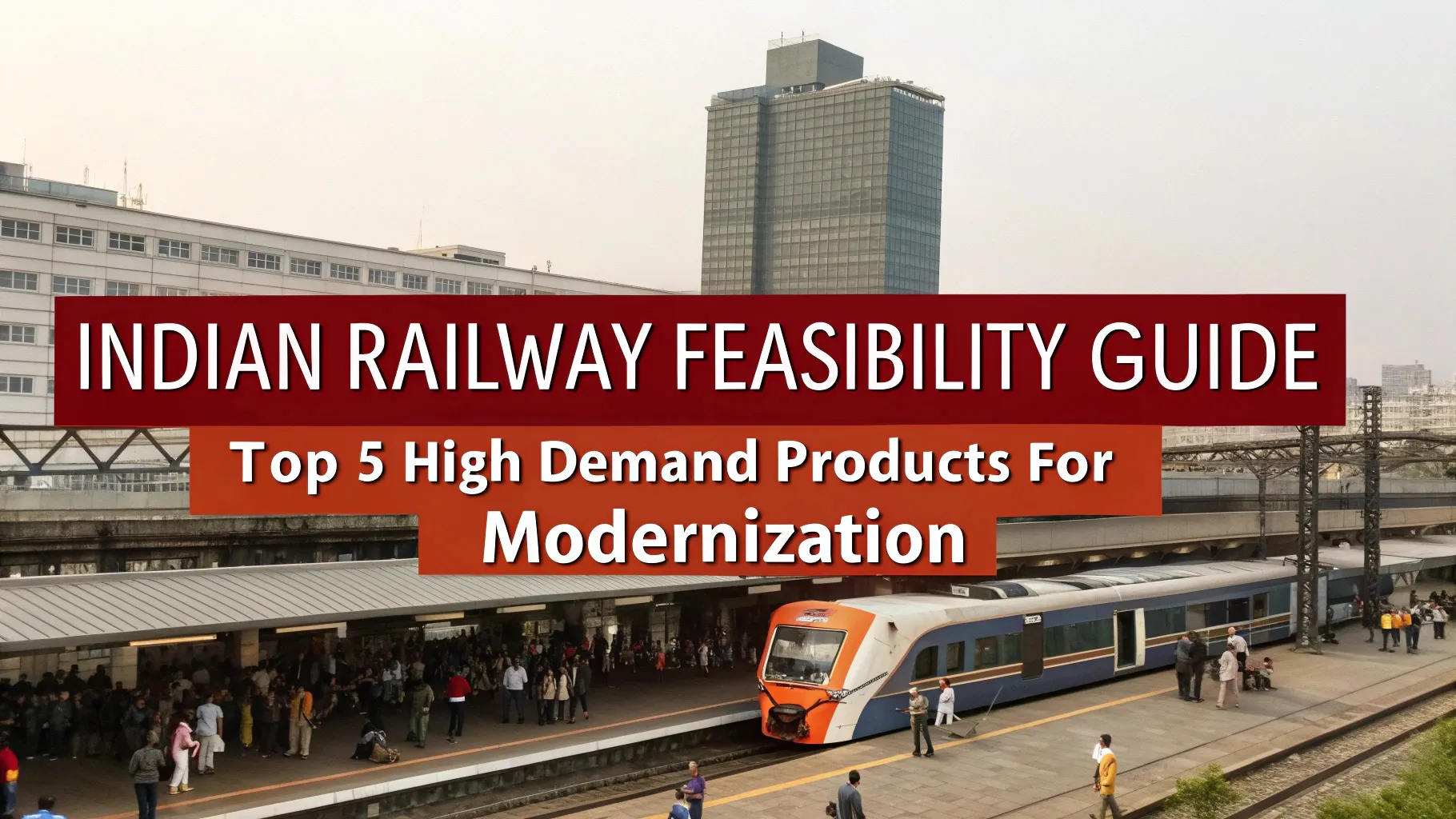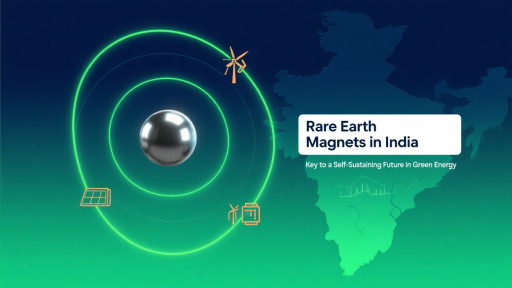India’s Railways Modernization Push and the Manufacturing Opportunity
Indian Railways is not only the backbone of the country; it also stands as one of the largest railway networks globally, traversing over 68,000 kilometers of track and servicing 23 million passengers daily. Beyond its scale, however, a significant change is underway. As India shifts towards upgrading and expanding its railway infrastructure, a strategic and commercial potential is emerging for industrial startups and manufacturing ventures beyond the traditional focus on trains and tracks.
The Indian railway industry is poised for transformation with the new target goals that include complete electrification by 2030, development of semi-high-speed corridors, station redevelopments, and implementation of smart energy-efficient technologies. There is now an urgent need for an entirely new ecosystem of updated hardware and specialized industrial components. This creates a multi-billion-rupee opportunity for startups and MSMEs to design and manufacture critical subsystems in five high-demand areas.
This article provides a project feasibility framework for entrepreneurs and engineers interested in B2B manufacturing and the new industrial opportunities created by the growth of Indian Railways. It contains the supporting documentation of technical descriptions, organized product details, scope of the manufacturing value chain, and a self-reliant India approach to railways aligning with “Make in India” and “Atmanirbhar Bharat” missions.
Related: Start your own Manufacturing Business of Concrete Railway Sleepers
Why Move Past Tracks and Engines? The Logic Behind It
For years, traditional railway contracts were monopolized by large Public Sector Undertakings (PSUs) dealing with tracks, engines, or entire wagons. With the modernization of Indian Railways, there is now an acute need for smart subcomponents and lightweight systems that are modular in nature and require decentralized manufacturing, making them suitable for SME and startup-level production.
Products of the future for railways include driver assistance systems, composite interior panels, modular toilets, digital signaling electronics, and lightweight pantographs, all of which pose volume demand and pre-defined technical spec harmony. Historically, many of these components were either imported or manufactured by a handful of suppliers, thereby creating significant space for new competitors.
Startups specializing in precision manufacturing, embedded electronics, plastics and composites, mechatronics, or electro-mechanical assembly are well-positioned to provide critical components for coaches, metro trains, semi-high-speed trains, or electrification infrastructure.
Key Product Areas for India’s Railway Manufacturing Potential
To explore the opportunity in detail, let us analyze the ecosystem via five specific product categories—each of them capturing unfulfilled domestic demand, policy focus, and accessible industrial entry.
| Product Category | Application in Modern Railways | Manufacturing Scope | Indigenous Demand Level |
| Smart Driver Assistance Systems | Safety and automation for loco drivers | Embedded systems, sensors, UI integration | High |
| Modular Bio-Vacuum Toilets | Clean, eco-friendly sanitation in coaches | Steel body, suction pump, vacuum tank, sensors | High |
| FRP/Aluminium Interior Panels | Light, fire-retardant interiors in modern coaches | Compression molding, FRP lamination, CNC | Very High |
| Lightweight Pantographs | Power collection for electric locomotives | Alloys, springs, linkages, carbon contacts | Medium |
| Digital Axle Counter Systems | Track vacancy detection in signaling | Sensor electronics, signal processors | High |
1. Smart Driver Assistance Systems (SDAS): Enhancing Safety Through Embedded Intelligence
The SDAS is a safety electronics suite installed on locomotives and EMUs that assists the driver with route navigation, speed control, obstacle detection, and signaling at the junctions. Indian Railways has made it compulsory to equip trains with SDAS on some routes as part of its safety modernization initiative.
Combined systems make use of sensor arrays, GPS modules, cameras, and user interfacing software. They require integration with ruggedized, EMI shielded hardware to real-time operating systems for reliable function.
Startups that specialize in embedded computing, HMI display units, data logging, and sensor calibration have the potential to manufacture key components of SDAS or offer complete system integration. Manufacturing opportunities include:
- Designing and populating printed circuit boards (PCBs)
- Producing and coating molds for electronic enclosures
- Integrating GPS, gyroscope, and image sensors
- Developing real-time software and power supply units
Due to the system’s modular architecture, even partial manufacturing (such as sensors or displays) has strong potential as entry points.
2. Redefining Coach Hygiene Using Modular Bio-Vacuum Toilets
The conversion of conventional open-discharge toilets to bio-vacuum modular systems represents one of the most significant changes to Indian Railways rolling stock. These modern toilets minimize water use and enhance hygiene for passengers, improving sanitation at track level to prevent contamination using vacuum suction.
Each modular unit includes:
- A stainless steel or polymer-based vacuum toilet bowl
- Bio-digester chamber with bacteria culture for waste breakdown
- Sensors for automated flush control, occupancy, and water level monitoring
- Electric suction pump, valves, and vent pipes
Designing these toilets involves several industrial areas such as metalworking, sensor technology, plastic molding, and electromechanical assembly. Components like bio-digesters and suction pumps are currently imported in bulk, thus highlighting the need for local manufacturing to support the railway coach modernization program. This is especially true for the Vande Bharat and LHB coaches.
3. FRP and Aluminum Composite Panels: Durable and Lightweight Interiors for Coaches
The interiors of today’s railway coaches are constructed with fire-retardant composites and aluminum-based honeycomb panels which are lightweight compared to heavy metals that are prone to rust. These materials compose the ceilings, walls, luggage shelves, doors, gangways, as well as in passenger and metro coaches.
Key Specifications Include:
- Conform to EN 45545 high flame retardancy
- Graffiti and scratch-resistant finish
- Modular structure for easy servicing
The manufacturing process includes:
- Compression molding of FRP (fiber reinforced plastics)
- Aluminum sheet lamination with adhesive honeycomb cores
- Shaped through CNC cutting and machining for precise dimensions
- Paint and coat with UV on surface
Companies dealing with composites, FRP tooling, or even fabrication of aluminum sheets can easily tap into this high-demand section. This is further encouraged by the rising need for lightweight coaches as well as the expansion of metro rail in tier 2 cities.
4. Lightweight Pantographs: Enabling Efficient Overhead Power Collection
Pantographs serve the purpose of drawing power from overhead wires (OHE) for Electric Trains and are positioned on the roof as mechanical linkages. They are most efficient when modern-day pants are lightweight, wear resistant, and have good aerodynamics.
Key mechanical elements include:
- Base frame made of aluminum or forged alloy
- Carbon collector strips with high conductivity
- Springs and linkages with precision-tuned contact pressure
- Insulators and rotary pneumatic actuators
The manufacturing process of pants includes precision fabrication, spring calibration, carbon brushing, and electro-mechanical testing. At the current moment, only a few international companies hold a monopoly in this industry. With respect to mechanical systems, metal forming, and motion control, Indian start-ups have the potential to penetrate the market starting with manufactural components then digitally evolving into full assemblies.
5. Digital Axle Counter Systems: The Backbone of Modern Signaling
Axle Counters are one of the key devices used for Railway Signaling as they determine if a particular track section is occupied. The move towards more reliable systems has necessitated the shift from traditional analog counters to digital axle counter systems which offer far superior reliability along with centralized signaling network integration.
- Inductive wheel sensors at track level
- Signal processing units (with redundancy)
- Real-time feedback to signaling control rooms
- Wireless or fiber optics
Startups can manufacture:
- Digital signal processors with railway-grade specifications
- EMI resistant casings and connectors
- Embedded software for logic-based occupancy detection
- Sensor mounting brackets and tools for alignment
Considering the modernization of railway signaling for core routes and the dedicated freight corridor (DFC), innovations in this area will have a continuous market over the next ten years.
Insights on Feasibility and Infrastructure Requirements for Manufacturing Facilities
| Product | Main Manufacturing Technologies Required | Testing/Standards Required | Production Scope |
| SDAS | Embedded systems, industrial boards, human machine interfaces (HMI) designs. | EMI/EMC and Railway Electronics Certification. | Moderate-Scale, Modular |
| Bio-Vacuum Toilets | Stainless steel fabrication, pumps and sensors. | Infrared (IR) testing protocols, ISO 9001 standards. | High-Volume, Assembly Line |
| FRP Panels | Compression molding and CNC trimming. | EN 45545 flammability testing. | Medium to Large Scale |
| Pantographs | Alloy forming and calibration jigs. | Wind tunnel, IEC and UIC norms testing. | Low-Volume, High Precision |
| Axle Counters | DSP coding, EMI casing, PCB integration, and PCB standard regulated. | RDSO Standard, EMI/EMC Testing. | Medium-Scale, Customizable |
For more information check out this video
How Startups May Enter the Railway Supply Chain
In order to supply to the Indian Railways, however, it is a necessity for the startups to register with RDSO (Research Designs & Standards Organization), and sometimes with Zonal Railway procurement systems or Metro corporations. Also, for most components shown above, they also fall under the Make II procurement which is a scheme that enables startups to build prototypes for demonstration and obtain direct procurement without prior experience.
Outlined steps for startups are:
- Identifying core capabilities such as electronics, fabrication, or composites.
- Design sample parts or units, undergo independent assessments.
- Register with GeM (Government e-Marketplace) and sign up for the Vendor Development Program.
- Partner with Coach Manufacturers like BEML, Titagarh, Alstom, Texmaco as part suppliers.
The strategic importance and industrial sustainability are provided through long-term contracts, policy priority, volume-linked scaling, as well as railway component manufacturing.
How NPCS Can Help Startups in Railway Component Manufacturing
Aligning an industrial unit with the modernization plans of Indian Railways requires an in-depth understanding of process flow, selection of raw materials, design of the plant layout, and compliance with regulatory standards.
In this regard, Niir Project Consultancy Services (NPCS) provides a reliable platform for new entrepreneurs to venture into this domain.
NPCS provides:
- Market Survey cum Detailed Techno-Economic Feasibility Report for Components Related to Rail and Transportation Systems.
- Complete breakdown on raw material sourcing to manufacturing, machinery and plant layout, testing norms, and beyond.
- Advisory on feasibility to help build sustainable and scaleable models aligned with railway demand cycles.
Which business to start? How to choose a business idea?
Final Remarks: Construct to Propel the Growth of the Nation
India’s railway transformation is more than the quest for higher speeds or better aesthetics. It focuses on modernizing and indigenizing more efficient technologies that systematically eliminate outdated legacy systems. While tracks and engines have always been the backbone of railways, innovation—and thus opportunity—now truly lies in the smarter, safer, and more passenger-friendly components, modules, and subsystems integrated into the trains.For MSMEs and startups with a visionary industrial perspective, now is a pivotal opportunity. The previously mentioned goods are not just in-demand, but also possible to produce with today’s available technologies. If entrepreneurs adopt a suitable tactical method alongside a dependable project plan, they can pave the way for railways of the future while simultaneously establishing sustainable enterprises.







